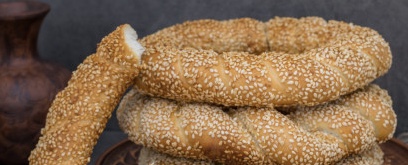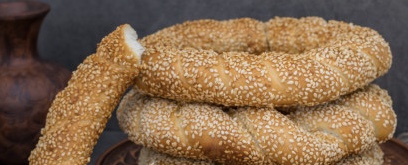



Simity - Turkish bagels on yeast dough, generously covered with sesame seeds. Unusually fragrant pastries with a crispy crust and tender, fluffy and fibrous crumb. If you've never made simits at home, be sure to do it: the recipe is simple and the result is amazing!
Yeast for making Turkish bagels does not have to be fast-acting - just dry (also 3 grams - this is 1 teaspoon without a slide) or pressed (you need 3 times more, that is, 9-10 grams) are perfect. Such yeast is not immediately mixed with flour, but pre-activated in a warm sweetish liquid for 10-15 minutes. In our case, you can slightly warm up the water with a tablespoon of sugar and dissolve the yeast in it.
In total, from the indicated amount of ingredients used, 4 large bagels are obtained (weighing about 90-100 grams each). Despite the lack of eggs, milk and butter in the yeast dough, the ready-made simits are quite insidious. This is me about calorie content: 100 grams of products contain almost 500 kcal. Therefore, be careful with these delicious bagels, girls!

Simity - Turkish bagels on yeast dough, generously covered with sesame seeds. Unusually fragrant pastries with a crispy crust and tender, fluffy and fibrous crumb. If you've never made simits at home, be sure to do it: the recipe is simple and the result is amazing!
Yeast for making Turkish bagels does not have to be fast-acting - just dry (also 3 grams - this is 1 teaspoon without a slide) or pressed (you need 3 times more, that is, 9-10 grams) are perfect. Such yeast is not immediately mixed with flour, but pre-activated in a warm sweetish liquid for 10-15 minutes. In our case, you can slightly warm up the water with a tablespoon of sugar and dissolve the yeast in it.
In total, from the indicated amount of ingredients used, 4 large bagels are obtained (weighing about 90-100 grams each). Despite the lack of eggs, milk and butter in the yeast dough, the ready-made simits are quite insidious. This is me about calorie content: 100 grams of products contain almost 500 kcal. Therefore, be careful with these delicious bagels, girls!
Sign up to receive email updates on new recipes.